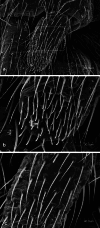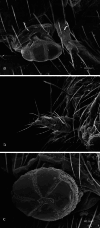A synopsis of the Campodeidae dipluran fauna from China (Arthropoda, Hexapoda) with a taxonomic key
- PMID: 40453767
- PMCID: PMC12125596
- DOI: 10.3897/zookeys.1239.144945
A synopsis of the Campodeidae dipluran fauna from China (Arthropoda, Hexapoda) with a taxonomic key
Abstract
This study provides a detailed examination of the taxonomy and distribution of 25 described Campodeidae diplurans species from the Chinese fauna, which frequently inhabit soil and cave environments. It involves the revision and rewriting of the diagnoses and descriptions for all taxa, based on prepared samples from Chinese scientific collections and new, unprocessed specimens observed via scanning electron microscopy for three species (Metriocampaurumqiensis, Leniwytsmaniaorientalis, and Lepidocampaweberi). In addition, the first taxonomic key for Chinese Campodeidae species is presented. This biodiversity includes four subfamilies: Campodeinae (12 species), Plusiocampinae (7 species), Lepidocampinae (5 species), and Syncampinae (1 species). Among these, 16 species are endemic to China, including five genera exclusive to the region: Pseudolibanocampa, Sinocampa, and Syncampa in soil environments, and Hubeicampa and Whittencampa in caves. The subfamily Syncampinae is only known in China. The richness of Campodeidae in China is the highest in East Asia, but relatively lower compared to the well-sampled and studied Euro-Mediterranean region, located at the opposite end of the Palearctic region. Nevertheless, East Asia should be considered as the origin of three campodeid subfamilies: Plusiocampinae, Lepidocampinae, and Syncampinae.
Keywords: Biodiversity; distribution; habitat; taxonomy; zoology.
Alberto Sendra, Jesús Selfa, Yun Bu, Yun-Xia Luan.
Conflict of interest statement
The authors have declared that no competing interests exist.
Figures











References
-
- Bareth C. (1992) Diploures Campodéidés du Nord-Est de Madagascar (InsectaApterygota). Journal of African Zoology 106(6): 489−497. https://pascal-francis.inist.fr/vibad/index.php?action=getRecordDetail&i...
-
- Bareth C, Condé B. (1958) Campodéidés endogés de l’ouest des États-Unis (Washinton, Oregon, Californie, Arizona). Bulletin de la Société Linneenne de Lyon 8: 226−248; 9: 265−276; 10: 297−304. 10.3406/linly.1958.8012 - DOI
-
- Bareth C, Condé B. (1974) Diploures Campodéidés des Iles Salomon. Revue d’Ecologie et de Biologie du Sol IX (2): 235−256.
-
- Chevrizov BP. (1978) Two new genera of the Family Campodeidae from the Far East Caves. Zoologichesky Zhurnal 57 (2): 197−205. https://digitalcommons.usf.edu/kip_articles/6532/
-
- Chou I, Chen T. (1980) Two new species of Campodeidae from Xinjiang (Apterygota: Diplura). Entomotaxonomia II (2): 157−160. http://xbkcflxb.alljournal.net/xbkcflxb/ch/reader/view_abstract.aspx?fil...
LinkOut - more resources
Full Text Sources
